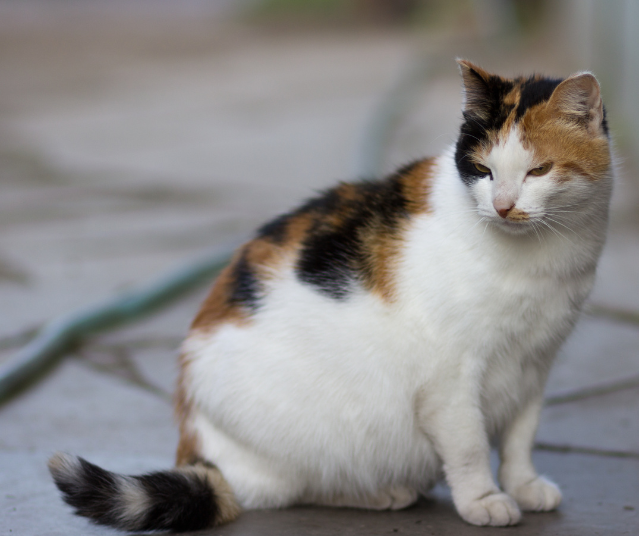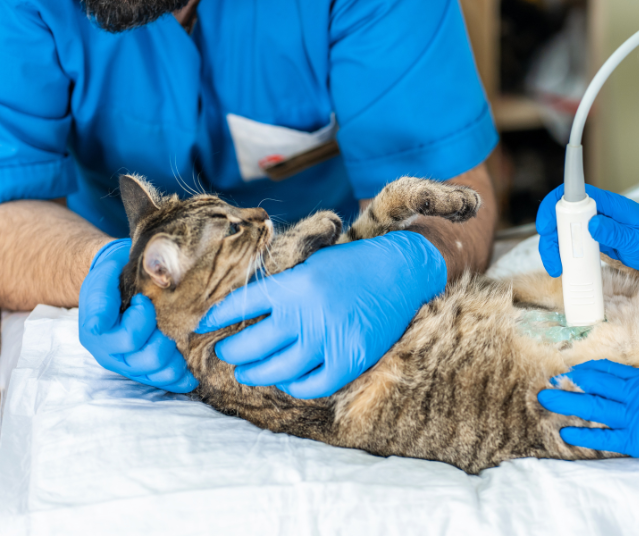Introduction to Cat Pregnancy
When your beloved feline is expecting, it’s an exciting yet slightly challenging journey. Understanding the signs, especially at early stages, can make the experience smoother for both you and your cat. One of the earliest and most noticeable signs of a cat’s pregnancy appears around the third week, when 3 Week Pregnant Cat Nipples start to change in appearance. This article will explore this sign, discuss what to expect throughout the pregnancy, and help you provide the best care for your pregnant cat.
How Long Are Cats Pregnant? Understanding the Timeline

Cats have a relatively short pregnancy period compared to humans. So, how long are cats pregnant exactly? Generally, a cat’s pregnancy lasts between 63 and 67 days, roughly translating to about nine weeks. However, some cats may give birth a bit earlier or later than this typical range. Knowing this timeline helps cat owners monitor their pet’s progress and recognize critical milestones in the pregnancy, such as changes in behavior, appetite, and physical characteristics, like the size and color of her nipples.
From conception, the development of the kittens begins almost immediately. By week three, the embryos are developing rapidly, causing hormonal changes that make a significant impact on the mother’s body. This stage, marked by the development of 3 Week Pregnant Cat Nipples, is a key early sign of pregnancy that can alert owners to her condition.
3 Week Pregnant Cat Nipples: Why They Change
3 Week Pregnant Cat Nipples go through a visible transformation that’s easy to spot with a careful look. These changes, often called “pinking up,” result from increased blood flow to the area and hormonal changes that prepare the cat’s body for the future demands of nursing. Around this time, the nipples begin to enlarge, becoming more noticeable, pinker, and slightly elongated. This physical transformation is necessary, as the cat’s body prepares for milk production to support her future kittens.
Hormones such as estrogen and progesterone play an essential role in this transformation. Estrogen levels, which rise after mating, help the body prepare for pregnancy, while progesterone supports the developing embryos. Together, these hormones influence several visible changes in your cat, and 3 Week Pregnant Cat Nipples are one of the earliest and most reliable indicators that kittens are on the way.
At around three weeks into pregnancy, a cat’s nipples often undergo noticeable changes. This transformation is an early indicator that she may be expecting. Here’s why it happens and what to look for:
1. Hormonal Shifts Prompt the Change
As soon as a cat becomes pregnant, her body undergoes a surge of pregnancy hormones, such as progesterone and estrogen. These hormones help prepare her body for the coming kittens, and one of their effects is on the mammary glands. Increased blood flow to these glands causes the nipples to become more prominent, which is sometimes called “pinking up.”
Cats experience hormonal shifts throughout their lives, impacting their behavior, physical health, and interactions with their environment. These shifts are most pronounced during certain life stages, such as puberty, mating seasons, pregnancy, and aging.
For example, as cats approach puberty, both males and females experience hormonal changes that prompt new behaviors, like spraying and territorial marking in males, or increased vocalization and restlessness in females. During the mating season, female cats undergo cycles of estrus, where hormone surges make them more receptive to mating and lead to notable behavioral changes, like rolling, yowling, and increased affection toward owners.
2. Color and Size Become Noticeable
Typically, a pregnant cat’s nipples, which were previously small and pale, become larger, pinker, and more pronounced. This happens because of increased blood circulation in the area as her body gears up for lactation. By the third week of pregnancy, this change becomes more visible and is often the first sign that cat owners notice.
At around three weeks of pregnancy, a cat’s nipples become more noticeable as they start to change in color and size. This early sign, known as “pinking up,” is often one of the first indicators that a cat may be pregnant.
The nipples appear rosier and slightly larger than usual due to increased blood flow and hormonal changes. This color and size shift is particularly noticeable if you are familiar with your cat’s usual appearance, helping cat owners identify the early stages of pregnancy.
3. Preparation for Nursing
The color and size changes in the 3 Week Pregnant Cat Nipples are part of the body’s natural preparation for milk production. While actual milk won’t begin to flow until later in the pregnancy or after birth, the mammary glands are already getting ready to nurse. The “pinking up” of the nipples signals that her body is preparing for the eventual need to feed her kittens.
Observing these nipple changes can provide a clue to her pregnancy, especially if the pregnancy is unplanned or if you are unsure of the timing.
When preparing for nursing, it’s important to recognize the early signs in cats, particularly around three weeks into pregnancy. At this stage, 3 Week Pregnant Cat Nipples may become more prominent and often change to a pinker color in a process known as “pinking up.”
This change signals that the cat’s body is starting to prepare for nursing her future kittens. By observing these early signs, such as changes in the 3 Week Pregnant Cat Nipples, cat owners can provide the right support during pregnancy. This includes ensuring a calm environment, offering high-quality nutrition, and scheduling a veterinary check-up to monitor the health of both the mother and her developing kittens.
Hidden Pregnancy Signs: Recognizing Early Symptoms in Cats
Cats can be excellent at hiding signs of illness or change, including pregnancy. However, a few hidden pregnancy signs beyond the nipple changes can help you confirm her condition. Watch for these subtle signs alongside changes in her nipples:
- Increased Affection: Some pregnant cats become more affectionate, seeking attention and even following their owners around the house.
- Decrease in Activity: A typically active cat may start to rest more frequently, showing signs of decreased energy as her body shifts to support the developing kittens.
- Appetite Changes: While some cats may initially show a reduced appetite, most will begin to eat more as the pregnancy progresses. This change in appetite, alongside the physical development of 3 Week Pregnant Cat Nipples, is another indication that kittens are on the way.
Knowing these hidden pregnancy signs can help you recognize her condition early, allowing you to provide the necessary care and support during the pregnancy.
Caring for Your Pregnant Cat: Early Pregnancy Tips
At this stage, your cat’s body undergoes significant changes to support the kittens’ development, so providing her with adequate care and a calm environment is essential. Here are some steps to ensure her well-being during early pregnancy:
- Provide High-Quality Nutrition: A pregnant cat requires a diet high in protein and fat to support the development of her kittens. Consider feeding her a specially formulated food for pregnant or nursing cats.
- Create a Safe Space: Cats need a calm, stress-free environment, especially when they’re pregnant. Designate a quiet area where she can relax without disturbances from other pets or loud noises.
- Regular Vet Visits: Regular veterinary check-ups are essential to monitor your cat’s health and ensure her pregnancy progresses smoothly. Discuss any changes you’ve observed, such as the development of long nipples or other physical signs of pregnancy.
Why Do Pregnant Cats Develop Long Nipples?
By the third week of pregnancy, long nipples often develop due to the body’s hormonal shifts as it prepares for lactation. These long nipples are typically a bit more prominent and can become slightly pink or red due to increased blood flow. It’s essential to note that this change is a natural part of your cat’s pregnancy, as her body readies itself to nurse her kittens once they’re born.
In addition to the 3 Week Pregnant Cat Nipples changes, you may observe your cat exhibiting nesting behavior, such as searching for cozy, quiet spots around the home. These signs indicate that her maternal instincts are kicking in, as she prepares for the arrival of her kittens.
Pregnant cats develop longer nipples as part of the natural changes their bodies undergo to prepare for nursing. As pregnancy progresses, hormonal shifts stimulate the mammary glands, causing the nipples to enlarge and become more prominent.
This enlargement of the 3 Week Pregnant Cat Nipples makes it easier for newborn kittens to latch on and feed. The increase in nipple size also serves as a clear sign to caregivers that the cat is progressing in her pregnancy, helping them prepare for the arrival of the kittens and ensuring the mother remains comfortable and well-nourished.
The Importance of Observing 3 Week Pregnant Cat Nipples for Pregnancy Confirmation

While there are other signs of pregnancy, 3 Week Pregnant Cat Nipples serve as one of the most reliable early indicators. When these physical changes accompany other symptoms, such as slight changes in appetite, affection, and activity levels, you can be relatively confident that your cat is indeed expecting. Early confirmation of pregnancy enables you to adjust her care needs and prepare for her kittens’ arrival in advance.
Understanding the Stages of Cat Pregnancy
A cat’s pregnancy progresses through three main stages: early pregnancy, mid-pregnancy, and late pregnancy. Here’s a breakdown of what to expect at each stage, including key physical and behavioral changes.
Early Pregnancy (Weeks 1-3)
At this stage, your cat’s nipples start to change in color and size as part of the 3 week pregnant cat nipples transformation. Her energy levels may drop slightly, and she may start displaying subtle affection or nesting behaviors. During early pregnancy, it’s essential to provide a balanced, high-protein diet to support her growing energy and nutritional needs.
In the early stages of a cat’s pregnancy, during weeks 1 to 3, you’ll start to notice subtle physical and behavioral changes as the pregnancy progresses. One of the first signs is a change in your cat’s 3 Week Pregnant Cat Nipples, which begin to become pinker and slightly enlarged—a process commonly referred to as “pinking up.”
This change occurs as blood flow to the area increases in preparation for nursing. During this time, the fertilized eggs implant in the uterine lining, and the embryos begin to develop. You may also notice hormonal shifts that make your cat more affectionate, as she seeks extra attention. Additionally, her 3 Week Pregnant Cat Nipples will continue to enlarge and become more pronounced as her body prepares for the next stages of pregnancy.
Additionally, some cats may experience a mild decrease in appetite due to nausea or hormonal changes, similar to morning sickness in humans. By the end of the third week, your veterinarian may be able to confirm the pregnancy through palpation, gently feeling the abdomen to detect small, developing embryos.
Mid-Pregnancy (Weeks 4-6)
By mid-pregnancy, your cat’s abdomen will start to expand noticeably. Her 3 Week Pregnant Cat Nipples will continue to enlarge, becoming more prominent and sometimes darker. You may also begin to feel slight movements from the developing kittens. As her appetite increases, it’s important to provide her with extra food to meet her growing dietary needs and support her pregnancy.
During the mid-pregnancy stage, typically between weeks 4 and 6, a cat’s pregnancy becomes more evident both physically and behaviorally. By this time, her belly will have started to enlarge noticeably, as the developing kittens grow rapidly.
Her appetite will significantly increase as she requires extra nutrients to support the growing litter. You may notice her grooming more frequently, a natural instinct as she prepares for the upcoming birth. Additionally, she may begin seeking out cozy, secluded spaces to “nest,” as part of her instinctual behavior. During this time, her 3 Week Pregnant Cat Nipples will also continue to develop, preparing her body for nursing.
At this stage, it’s essential to provide your cat with high-quality, nutrient-rich food, ideally a diet formulated for pregnant or nursing cats, to support her health and the development of her kittens. Be mindful to avoid handling her belly, as the growing kittens are sensitive, and any pressure could cause discomfort. You may also notice her 3 Week Pregnant Cat Nipples becoming more prominent, signaling the changes occurring as she prepares for the birth.
As she enters the final weeks of her pregnancy, extra care and monitoring will ensure she’s as comfortable and healthy as possible for the arrival of her new litter.
Late Pregnancy (Weeks 7-9)
In the final stages of pregnancy, your cat’s movements become more noticeable, and her belly will appear visibly round. She may start showing increased nesting behavior, seeking a quiet, safe spot to give birth. Pay close attention to her 3 Week Pregnant Cat Nipples, as they will continue to change, and monitor her overall health. It’s also a good idea to consult with your vet to create a birthing plan and prepare a comfortable nesting area for her.
During the late pregnancy stage of a cat, which occurs between weeks 7 and 9, significant changes occur as the kittens develop and grow rapidly. By week 7, your cat’s belly will noticeably enlarge, and you’ll likely see more pronounced movements as the kittens shift inside. Around this time, you may also notice changes in the 3 Week Pregnant Cat Nipples, which will continue to develop as she prepares for birth.
As the pregnancy progresses, the mother cat may become more restless and begin seeking out a quiet, comfortable place to give birth. In the final weeks, her appetite may increase as her body works to support the growing kittens. You’ll also notice changes in her 3 Week Pregnant Cat Nipples as they continue to develop. It’s essential to provide her with high-quality, nutrient-rich food to meet the increased demands of her pregnancy and ensure the health of both the mother and her kittens.
As labor approaches, your cat may start exhibiting nesting behaviors, like scratching or arranging bedding in a quiet, secluded area. During these final weeks, you’ll also notice continued changes in her 3 Week Pregnant Cat Nipples. To ensure both the mother and her kittens remain healthy and ready for birth, it’s important to provide extra care, maintain a safe environment, and monitor her health closely.
Preparing for the Kittens: Final Weeks of Pregnancy

As your cat’s due date nears, preparation is key. Create a quiet, warm space in your home where she can comfortably give birth. A shallow box lined with soft towels is ideal, offering both comfort and containment for the mother and her kittens. During this time, you’ll also notice changes in her 3 Week Pregnant Cat Nipples, which will continue to develop as she nears labor.
Consulting with your veterinarian during these final weeks is highly recommended. The vet can provide advice on what to expect during labor, potential complications, and steps to take in case of an emergency. Understanding how to support your cat during labor is essential for a smooth birthing process.
KNOW MORE : 3 Week Pregnant Dog Nipples
FAQs About Cat Pregnancy and 3 Week Pregnant Cat Nipples
How Long Are Cats Pregnant?
Cats are generally pregnant for around 63-67 days, or about nine weeks. Recognizing changes like 3 Week Pregnant Cat Nipples and understanding the pregnancy timeline ensures you’re well-prepared for each stage.
Are Long Nipples Normal in Pregnant Cats?
Yes, long nipples are a common and normal part of pregnancy in cats. The nipples begin to enlarge around the third week, preparing for nursing.
What Other Hidden Pregnancy Signs Should I Watch For?
In addition to 3 Week Pregnant Cat Nipples, look out for subtle behavior changes, appetite fluctuations, and reduced activity levels. These signs, while less obvious, help confirm pregnancy and allow you to care for your cat effectively.
There are other subtle signs of pregnancy in cats that you can watch for. Early on, a pregnant cat may exhibit increased affection or, conversely, become more withdrawn.
Changes in appetite are common; some cats may eat more, while others experience a temporary decrease. You might also notice slight weight gain around the abdomen as the pregnancy progresses. Behavioral changes, like nesting instincts or seeking out quieter spaces, are also clues.
Observing these signs can help you better support your cat during her pregnancy and prepare for her upcoming needs.
Read More : Pregnancy And Parturition In Cats
Conclusion: Recognizing and Supporting Cat Pregnancy
Knowing what to expect during your cat’s pregnancy can make the experience rewarding and less stressful. From observing 3 Week Pregnant Cat Nipples to understanding the timeline of feline pregnancy, each stage brings unique milestones. Recognizing these early indicators and responding with proper care and preparation ensures a safe and healthy pregnancy journey for your cat and her future kittens.










